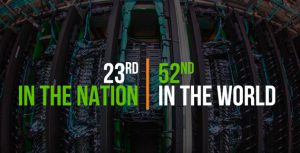Joule Supercomputer
 NETL’s highly ranked Joule 2.0 supercomputer is breaking barriers by accelerating the development of innovative, cost-effective energy technologies to ensure affordable, reliable energy for all Americans.
NETL’s highly ranked Joule 2.0 supercomputer is breaking barriers by accelerating the development of innovative, cost-effective energy technologies to ensure affordable, reliable energy for all Americans.
The high-performance system ranked 23rd in the United States and 52nd in the world in it’s debut ranking by TOP500. A recent $16.5 million upgrade boosted Joule’s computational power by nearly eight times, enabling researchers to tackle more challenging problems than ever before as they work to make more efficient use of the nation’s vast fossil fuel resources.
Named for the familiar unit of energy, Joule allows researchers to model energy technologies, simulate challenging phenomena and solve complex calculations using computational tools that save time and money to ensure that technology development ultimately proves successful. The upgrade work more than tripled the number of central processing unit (CPU) cores — from 24,192 to 74,240 — and added graphics processing units to further enhance simulations of advanced energy technologies.
The upgrade to Joule 2.0 also boosted the system’s computational power to 5.767 PFLOPS, meaning that it can perform more than 5 quadrillion calculations per second. That’s equivalent to roughly 54,658 desktop computers combined.
Joule 2.0 Facts
- Joule’s total memory is 271 terabytes, or about the same as 68,033 desktop computers.
- Joule 2.0 can store 11.6 petabytes of data, which equates to almost 1,181 copies of the information stored by the Library of Congress.
- Joule 2.0 has a network bandwidth of 83.2 terabytes per second — enough capacity to simultaneously stream 10.4 million high-definition movies on Netflix.
- A gifted mathematician working 40 hours a week for 50 weeks per year would take about 55.9 billion years to do what Joule 2.0 can do in one second. Alternatively, 1 billion people working 40 hours a week for 50 weeks per year would take about 55.9 years to do what Joule 2.0 can do in one second.
- Sixty-seven trillion sheets of paper and 1.68 trillion pens would be required to write out the results of the operations performed every second by Joule 2.0.
Joule is used by a broad range of NETL projects and programs aimed at developing technological solutions to America’s energy challenges, from deepening our understanding of advanced combustion processes to optimizing chemical reactor designs. A study conducted prior to the upgrade indicated that Joule impacts more than 50 percent of the Lab’s research publications, in which information is shared with the research community to accelerate technology development.
“Joule is a fundamental piece of scientific infrastructure at NETL,” Chief Information Officer Antonio Ferreira said. “Computational science enables us to simulate experiments that would cost thousands, maybe even millions, of dollars in a controlled environment and look at things that we can’t always look at when we conduct an experiment — whether it’s examining individual atoms in an alloy to determine its strength or looking at the efficiency of a gas turbine operating at a power plant. Studying those things computationally allows us to consider many more options in a way that saves time and money. That means when we build the next generation of power plants to serve the United States for the next 50 years, we’re able to consider more many more designs and come up with a power plant that does a better job and provides cheaper energy with a reduced impact on the environment.”
NETL recently welcomed U.S. Senator Shelley Moore Capito, U.S. Representative David McKinley, U.S. Department of Energy Assistant Secretary for Fossil Energy Steven Winberg and a representative from U.S. Senator Joe Manchin’s office to celebrate the upgrade at a dedication event held June 14 at the Lab’s Morgantown, West Virginia, site. While Joule is based in Morgantown, dedicated space for collaboration and simulation work is also provided at NETL’s sites in Pittsburgh and Albany, Oregon.
Supercomputing is essential in achieving NETL’s mission to discover, integrate and mature technology solutions that enhance the nation’s energy foundation and protect the environment for future generations. By expediting technology development through computational science and engineering, Joule helps NETL cut costs, save time and spur valuable economic investments with a global impact.
